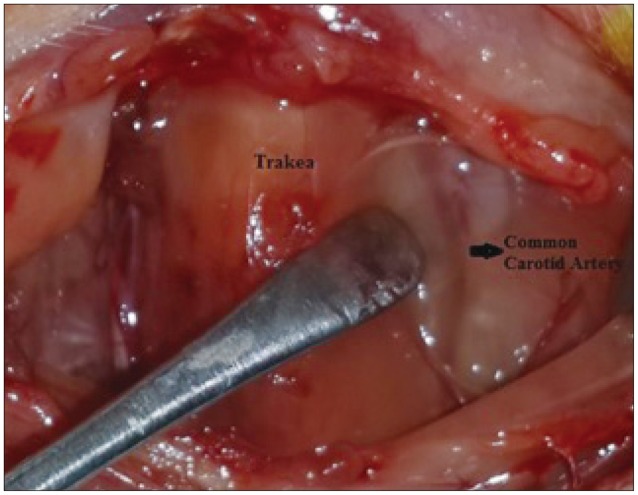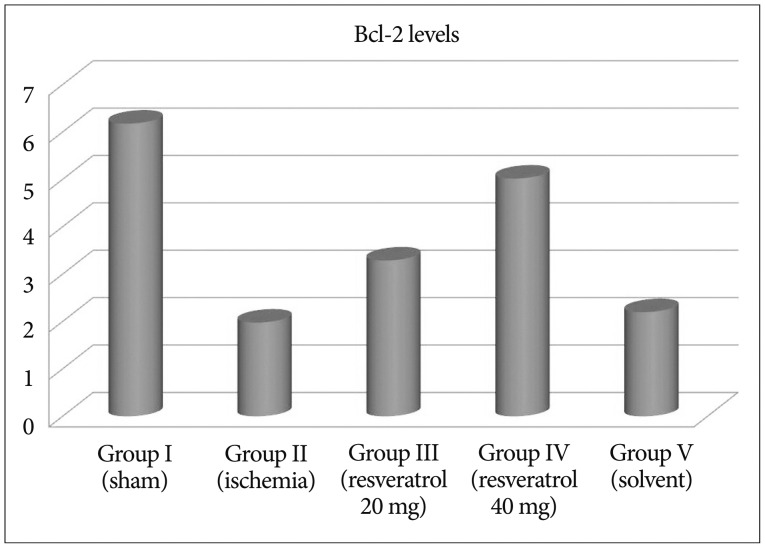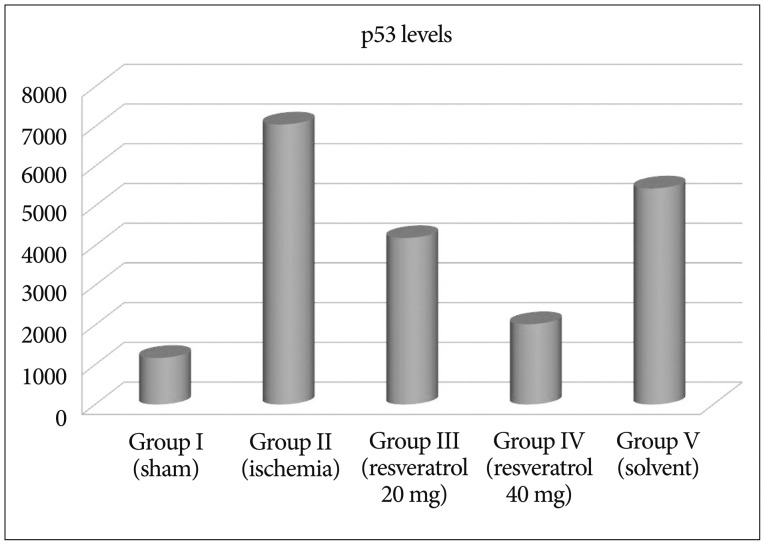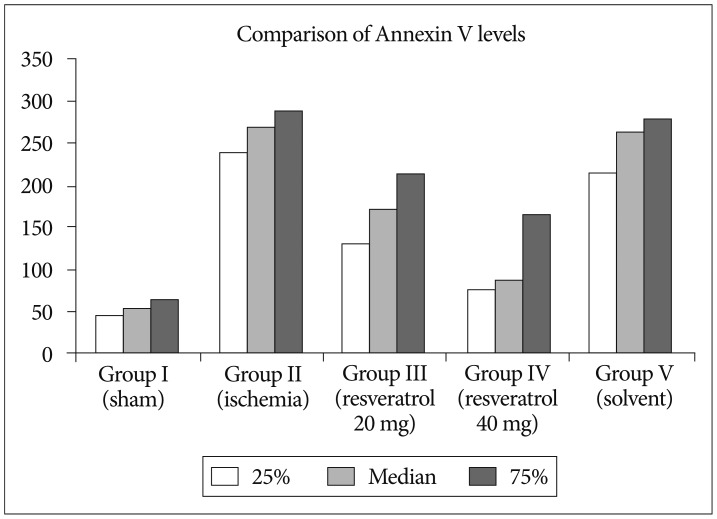J Korean Neurosurg Soc.
2015 Dec;58(6):508-512. 10.3340/jkns.2015.58.6.508.
Neuroprotective Effect of Resveratrol on Acute Brain Ischemia Reperfusion Injury by Measuring Annexin V, p53, Bcl-2 Levels in Rats
- Affiliations
-
- 1Department of Neurosurgery, Katip Celebi University Izmir Ataturk Training and Research Hospital, Izmir, Turkey.
- 2Department of Neurosurgery, Eskisehir State Hospital, Eskisehir, Turkey.
- 3Department of Pharmacology, Eskisehir Osmangazi University, Eskisehir, Turkey.
- 4Department of Neurosurgery, Dokuz Eylul University, School of Medicine Hospital, Izmir, Turkey. okalemci@gmail.com
- 5Department of Neurosurgery, Eskisehir Osmangazi University School of Medicine Hospital, Eskisehir, Turkey.
- KMID: 2151151
- DOI: http://doi.org/10.3340/jkns.2015.58.6.508
Abstract
- BACKGROUND
Cerebral ischemia is as a result of insufficient cerebral blood flow for cerebral metabolic functions. Resveratrol is a natural phytoalexin that can be extracted from grape's skin and had potent role in treating the cerebral ischemia. Apoptosis, a genetically programmed cellular event which occurs after ischemia and leads to biochemical and morphological changes in cells. There are some useful markers for apoptosis like Bcl-2, bax, and p53. The last reports, researchers verify the apoptosis with early markers like Annexin V.
METHODS
We preferred in this experimental study a model of global cerebral infarction which was induced by bilateral common carotid artery occlusion method. Rats were randomly divided into 4 groups : sham, ischemia-reperfusion (I/R), I/R plus 20 mg/kg resveratrol and I/R plus 40 mg/kg resveratrol. Statistical analysis was performed using Sigmastat 3.5 ve IBM SPSS Statistics 20. We considered a result significant when p<0.001.
RESULTS
After administration of resveratrol, Bcl-2 and Annexin levels were significantly increased (p<0.001). Depending on the dose of resveratrol, Bcl2 levels increased, p53 levels decreased but Annexin V did not effected. P53 levels were significantly increased in ishemia group, so apoptosis is higher compared to other groups.
CONCLUSION
In the acute period, Annexin V levels misleading us because the apoptotic cell counts could not reach a certain level. Therefore we should support our results with bcl-2 and p53.
Keyword
MeSH Terms
Figure
Reference
-
1. Aboutaleb N, Shamsaei N, Khaksari M, Erfani S, Rajabi H, Nikbakht F. Pre-ischemic exercise reduces apoptosis in hippocampal CA3 cells after cerebral ischemia by modulation of the Bax/Bcl-2 proteins ratio and prevention of caspase-3 activation. J Physiol Sci. 2015; 65:435–443. PMID: 26012958.
Article2. Aggarwal BB, Bhardwaj A, Aggarwal RS, Seeram NP, Shishodia S, Takada Y. Role of resveratrol in prevention and therapy of cancer : preclinical and clinical studies. Anticancer Res. 2004; 24(5A):2783–2840. PMID: 15517885.3. Choi SK, Lee GJ, Choi S, Kim YJ, Park HK, Park BJ. Neuroprotective effects by nimodipine treatment in the experimental global ischemic rat model : real time estimation of glutamate. J Korean Neurosurg Soc. 2011; 49:1–7. PMID: 21494355.
Article4. de la Lastra CA, Villegas I. Resveratrol as an antioxidant and pro-oxidant agent : mechanisms and clinical implications. Biochem Soc Trans. 2007; 35(Pt 5):1156–1160. PMID: 17956300.5. del Zoppo GJ. Microvascular responses to cerebral ischemia/inflammation. Ann N Y Acad Sci. 1997; 823:132–147. PMID: 9292040.
Article6. Di Carlo A. Human and economic burden of stroke. Age Ageing. 2009; 38:4–5. PMID: 19141505.
Article7. Donnan GA, Fisher M, Macleod M, Davis SM. Stroke. Lancet. 2008; 371:1612–1623. PMID: 18468545.
Article8. Federico A, Cardaioli E, Da Pozzo P, Formichi P, Gallus GN, Radi E. Mitochondria, oxidative stress and neurodegeneration. J Neurol Sci. 2012; 322:254–262. PMID: 22669122.
Article9. Green DR, Chipuk JE. p53 and metabolism : inside the TIGAR. Cell. 2006; 126:30–32. PMID: 16839873.10. Iwasaki Y, Ito S, Suzuki M, Nagahori T, Yamamoto T, Konno H. Forebrain ischemia induced by temporary bilateral common carotid occlusion in normotensive rats. J Neurol Sci. 1989; 90:155–165. PMID: 2723680.
Article11. Juhasz B, Varga B, Gesztelyi R, Kemeny-Beke A, Zsuga J, Tosaki A. Resveratrol : a multifunctional cytoprotective molecule. Curr Pharm Biotechnol. 2010; 11:810–818. PMID: 20874691.12. Kaburaki J, Kuwana M, Yamamoto M, Kawai S, Ikeda Y. Clinical significance of anti-annexin V antibodies in patients with systemic lupus erythematosus. Am J Hematol. 1997; 54:209–213. PMID: 9067499.
Article13. Khan M, Sekhon B, Jatana M, Giri S, Gilg AG, Sekhon C, et al. Administration of N-acetylcysteine after focal cerebral ischemia protects brain and reduces inflammation in a rat model of experimental stroke. J Neurosci Res. 2004; 76:519–527. PMID: 15114624.
Article14. Lahiry L, Saha B, Chakraborty J, Bhattacharyya S, Chattopadhyay S, Banerjee S, et al. Contribution of p53-mediated bax transactivation in theaflavin-induced mammary epithelial carcinoma cell apoptosis. Apoptosis. 2008; 13:771–781. PMID: 18454316.
Article15. Lakhan SE, Kirchgessner A, Hofer M. Inflammatory mechanisms in ischemic stroke : therapeutic approaches. J Transl Med. 2009; 7:97. PMID: 19919699.16. Lee KO, Kim WJ, Na SJ, Heo JH, Lee KY. Clinical significance of anti-annexin V antibody in acute cerebral ischemia. J Neurol Sci. 2011; 305:53–56. PMID: 21450308.
Article17. Li C, Yan Z, Yang J, Chen H, Li H, Jiang Y, et al. Neuroprotective effects of resveratrol on ischemic injury mediated by modulating the release of neurotransmitter and neuromodulator in rats. Neurochem Int. 2010; 56:495–500. PMID: 20026214.
Article18. Li H, Yan Z, Zhu J, Yang J, He J. Neuroprotective effects of resveratrol on ischemic injury mediated by improving brain energy metabolism and alleviating oxidative stress in rats. Neuropharmacology. 2011; 60:252–258. PMID: 20868700.
Article19. Li Z, Pang L, Fang F, Zhang G, Zhang J, Xie M, et al. Resveratrol attenuates brain damage in a rat model of focal cerebral ischemia via up-regulation of hippocampal Bcl-2. Brain Res. 2012; 1450:116–124. PMID: 22410291.
Article20. Lieberthal W, Menza SA, Levine JS. Graded ATP depletion can cause necrosis or apoptosis of cultured mouse proximal tubular cells. Am J Physiol. 1998; 274(2 Pt 2):F315–F327. PMID: 9486226.21. Love S. Apoptosis and brain ischaemia. Prog Neuropsychopharmacol Biol Psychiatry. 2003; 27:267–282. PMID: 12657366.
Article22. Lu X, Xu H, Sun B, Zhu Z, Zheng D, Li X. Enhanced neuroprotective effects of resveratrol delivered by nanoparticles on hydrogen peroxide-induced oxidative stress in rat cortical cell culture. Mol Pharm. 2013; 10:2045–2053. PMID: 23534345.
Article23. Mackay J, Mensah GA, Mendis S, Greenlund K. The atlas of heart disease and stroke. Geneva: World Health Organization;2004.24. Mahajan NP, Linder K, Berry G, Gordon GW, Heim R, Herman B. Bcl-2 and bax interactions in mitochondria probed with green fluorescent protein and fluorescence resonance energy transfer. Nat Biotechnol. 1998; 16:547–552. PMID: 9624685.
Article25. Markus MA, Morris BJ. Resveratrol in prevention and treatment of common clinical conditions of aging. Clin Interv Aging. 2008; 3:331–339. PMID: 18686754.26. Mohagheghi F, Khalaj L, Ahmadiani A, Rahmani B. Gemfibrozil pretreatment affecting antioxidant defense system and inflammatory, but not Nrf-2 signaling pathways resulted in female neuroprotection and male neurotoxicity in the rat models of global cerebral ischemia-reperfusion. Neurotox Res. 2013; 23:225–237. PMID: 22773136.
Article27. Molchadsky A, Shats I, Goldfinger N, Pevsner-Fischer M, Olson M, Rinon A, et al. p53 plays a role in mesenchymal differentiation programs, in a cell fate dependent manner. PLoS One. 2008; 3:e3707. PMID: 19002260.
Article28. Mukherjee PK, Ahamed KF, Kumar V, Mukherjee K, Houghton PJ. Protective effect of biflavones from araucaria bidwillii hook in rat cerebral ischemia/reperfusion induced oxidative stress. Behav Brain Res. 2007; 178:221–228. PMID: 17250903.
Article29. Nassar NN, Abdelsalam RM, Abdel-Rahman AA, Abdallah DM. Possible involvement of oxidative stress and inflammatory mediators in the protective effects of the early preconditioning window against transient global ischemia in rats. Neurochem Res. 2012; 37:614–621. PMID: 22113727.
Article30. Orsu P, Murthy BV, Akula A. Cerebroprotective potential of resveratrol through anti-oxidant and anti-inflammatory mechanisms in rats. J Neural Transm (Vienna). 2013; 120:1217–1223. PMID: 23371441.
Article31. Park HS, Han KH, Shin JA, Park JH, Song KY, Kim DH. The neuroprotective effects of carnosine in early stage of focal ischemia rodent model. J Korean Neurosurg Soc. 2014; 55:125–130. PMID: 24851146.
Article32. Pathak D, Berthet A, Nakamura K. Energy failure : does it contribute to neurodegeneration? Ann Neurol. 2013; 74:506–516. PMID: 24038413.33. Phillis JW, O'Regan MH. Characterization of modes of release of amino acids in the ischemic/reperfused rat cerebral cortex. Neurochem Int. 2003; 43:461–467. PMID: 12742092.
Article34. Prabhakar O. Cerebroprotective effect of resveratrol through antioxidant and anti-inflammatory effects in diabetic rats. Naunyn Schmiedebergs Arch Pharmacol. 2013; 386:705–710. PMID: 23612842.
Article35. Qin ZH, Chen RW, Wang Y, Nakai M, Chuang DM, Chase TN. Nuclear factor kappaB nuclear translocation upregulates c-Myc and p53 expression during NMDA receptor-mediated apoptosis in rat striatum. J Neurosci. 1999; 19:4023–4033. PMID: 10234031.
Article36. Rami A. Ischemic neuronal death in the rat hippocampus : the calpain-calpastatin-caspase hypothesis. Neurobiol Dis. 2003; 13:75–88. PMID: 12828932.
Article37. Raynal P, Pollard HB. Annexins : the problem of assessing the biological role for a gene family of multifunctional calcium- and phospholipid-binding proteins. Biochim Biophys Acta. 1994; 1197:63–93. PMID: 8155692.
Article38. Shin JA, Lee KE, Kim HS, Park EM. Acute resveratrol treatment modulates multiple signaling pathways in the ischemic brain. Neurochem Res. 2012; 37:2686–2696. PMID: 22878646.
Article39. Sinha K, Chaudhary G, Gupta YK. Protective effect of resveratrol against oxidative stress in middle cerebral artery occlusion model of stroke in rats. Life Sci. 2002; 71:655–665. PMID: 12072154.
Article40. Slemmer JE, Shacka JJ, Sweeney MI, Weber JT. Antioxidants and free radical scavengers for the treatment of stroke, traumatic brain injury and aging. Curr Med Chem. 2008; 15:404–414. PMID: 18288995.
Article41. Steckley D, Karajgikar M, Dale LB, Fuerth B, Swan P, Drummond-Main C, et al. Puma is a dominant regulator of oxidative stress induced bax activation and neuronal apoptosis. J Neurosci. 2007; 27:12989–12999. PMID: 18032672.
Article42. van Heerde WL, Poort S, van't Veer C, Reutelingsperger CP, de Groot PG. Binding of recombinant annexin V to endothelial cells : effect of annexin V binding on endothelial-cell-mediated thrombin formation. Biochem J. 1994; 302(Pt 1):305–312. PMID: 8068019.
Article43. Vidavalur R, Otani H, Singal PK, Maulik N. Significance of wine and resveratrol in cardiovascular disease : French paradox revisited. Exp Clin Cardiol. 2006; 11:217–225. PMID: 18651034.44. Wang Q, Xu J, Rottinghaus GE, Simonyi A, Lubahn D, Sun GY, et al. Resveratrol protects against global cerebral ischemic injury in gerbils. Brain Res. 2002; 958:439–447. PMID: 12470882.
Article45. Warlow C, Sudlow C, Dennis M, Wardlaw J, Sandercock P. Stroke. Lancet. 2003; 362:1211–1224. PMID: 14568745.
Article46. White BC, Sullivan JM, DeGracia DJ, O'Neil BJ, Neumar RW, Grossman LI, et al. Brain ischemia and reperfusion : molecular mechanisms of neuronal injury. J Neurol Sci. 2000; 179(S 1-2):1–33. PMID: 11054482.47. Wong CH, Crack PJ. Modulation of neuro-inflammation and vascular response by oxidative stress following cerebral ischemia-reperfusion injury. Curr Med Chem. 2008; 15:1–14. PMID: 18220759.
Article48. Yılmaz MB, Tönge M, Emmez H, Kaymaz F, Kaymaz M. Neuroprotective effects of quetiapine on neuronal apoptosis following experimental transient focal cerebral ischemia in rats. J Korean Neurosurg Soc. 2013; 54:1–7. PMID: 24044072.
Article
- Full Text Links
- Actions
-
Cited
- CITED
-
- Close
- Share
- Similar articles
-
- Resveratrol modulates the Akt/GSK-3β signaling pathway in a middle cerebral artery occlusion animal model
- The Neuroprotective Effects of Woohwangcheongsim-won on Cerebral Ischemia following the Middle Cerebral Artery Occlusion in Rats
- Effectiveness of propofol pretreatment on the extent of deranged cerebral mitochondrial oxidative enzyme system after incomplete forebrain ischemia/reperfusion in rats
- Neuroprotective effects of resveratrol via anti-apoptosis on hypoxic-ischemic brain injury in neonatal rats
- Quantitative Analysis of Agmatine by HPLC in Ischemic Brain





